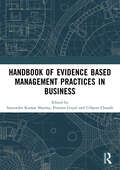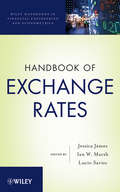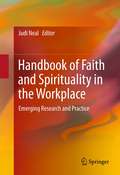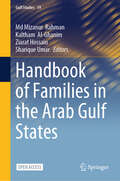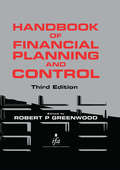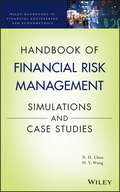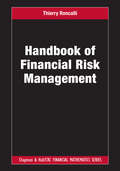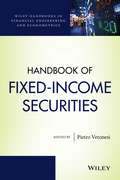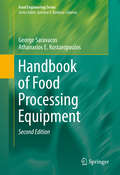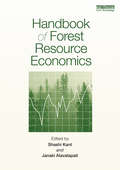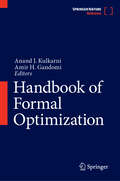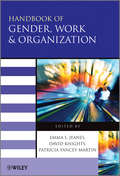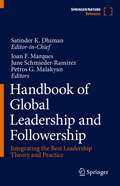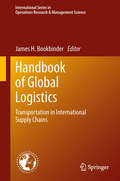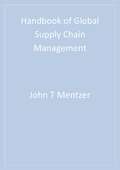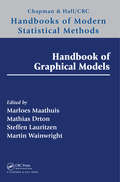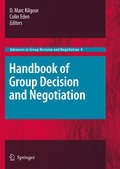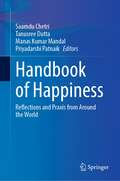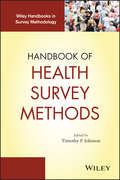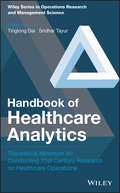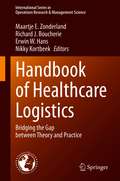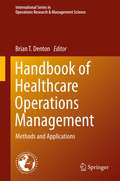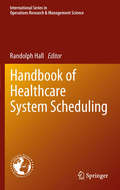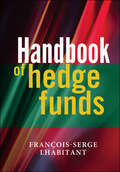- Table View
- List View
Handbook of Evidence Based Management Practices in Business
by Satyendra Kumar Sharma Praveen Goyal Udayan ChandaThis book is a collection of selected high-quality research papers presented at the 4th International Conference on Evidence-Based Management (ICEBM) 2023, held at Birla Institute of Technology & Science, Pilani, Rajasthan, India, during February 24–25, 2023. It has 76 chapters written by various scholars focusing on evidence-based management practices in different functional areas of management with the application of theory and empirical techniques. This book will be helpful to practitioners, academics, scholars, and policymakers.
Handbook of Exchange Rates
by Lucio Sarno Ian Marsh Jessica JamesPraise for Handbook of Exchange Rates"This book is remarkable. I expect it to become the anchor reference for people working in the foreign exchange field."--Richard K. Lyons, Dean and Professor of Finance, Haas School of Business, University of California Berkeley"It is quite easily the most wide ranging treaty of expertise on the forex market I have ever come across. I will be keeping a copy close to my fingertips."--Jim O'Neill, Chairman, Goldman Sachs Asset ManagementHow should we evaluate the forecasting power of models? What are appropriate loss functions for major market participants? Is the exchange rate the only means of adjustment? Handbook of Exchange Rates answers these questions and many more, equipping readers with the relevant concepts and policies for working in today's international economic climate.Featuring contributions written by leading specialists from the global financial arena, this handbook provides a collection of original ideas on foreign exchange (FX) rates in four succinct sections:* Overview introduces the history of the FX market and exchange rate regimes, discussing key instruments in the trading environment as well as macro and micro approaches to FX determination.* Exchange Rate Models and Methods focuses on forecasting exchange rates, featuring methodological contributions on the statistical methods for evaluating forecast performance, parity relationships, fair value models, and flow-based models.* FX Markets and Products outlines active currency management, currency hedging, hedge accounting; high frequency and algorithmic trading in FX; and FX strategy-based products.* FX Markets and Policy explores the current policies in place in global markets and presents a framework for analyzing financial crises.Throughout the book, topics are explored in-depth alongside their founding principles. Each chapter uses real-world examples from the financial industry and concludes with a summary that outlines key points and concepts.Handbook of Exchange Rates is an essential reference for fund managers and investors as well as practitioners and researchers working in finance, banking, business, and econometrics. The book also serves as a valuable supplement for courses on economics, business, and international finance at the upper-undergraduate and graduate levels.
Handbook of Faith and Spirituality in the Workplace
by Judi NealWhile the field of management has developed as a research discipline over the last century, until the early 1990s there was essentially no acknowledgement that the human spirit plays an important role in the workplace. Over the past twenty years, the tide has begun to turn, as evidenced by the growing number of courses in academia and in corporate training, and an exponential increase in the publications emerging through creative interaction of scholars and practitioners in organizational behaviour, workplace diversity, sustainability, innovation, corporate governance, leadership, and corporate wellness, as well as contributions by psychotherapists, theologians, anthropologists, educators, philosophers, and artists. This Handbook is the most comprehensive collection to date of essays by the preeminent researchers and practitioners in faith and spirituality in the workplace, featuring not only the most current research and case examples, but visions of what will be, or should be, emerging over the horizon. It includes essays by the people who helped to pioneer the field as well as essays by up and coming young scholars. Among the questions and issues addressed: · What does it mean to be a "spiritual" organization? How does this perspective challenge traditional approaches to the firm as a purely rational, profit-maximizing enterprise? · Is faith and spirituality in the workplace a passing fad, or is there a substantial shift occurring in the business paradigm? · How does this field inform emerging management disciplines such as sustainability, diversity, and social responsibility? · In what ways are faith and spirituality in the workplace similar to progressive and innovative human resource practices. Does faith and spirituality in the workplace bring something additional to the conversation, and if so, what? The aim of The Handbook of Faith and Spirituality in the Workplace is to provide researchers, faculty, students, and practitioners with a broad overview of the field from a research perspective, while keeping an eye on building a bridge between scholarship and practice.
Handbook of Families in the Arab Gulf States (Gulf Studies #19)
by Md Mizanur Rahman Ziarat Hossain Kaltham Al-Ghanim Sharique UmarThis open access book collates and advances the body of knowledge about the factors, directions, and magnitudes of change in Arabian Gulf families from interdisciplinary perspectives. Family life across the globe is being impacted by unprecedented diversity in household living arrangements and by sweeping economic, cultural, and social change, and this is not an exception in the Gulf region. The book demarcates how Gulf families are experiencing many formidable challenges and undergoing profound changes due to speedy economic transformation, educational reforms, extensive use of social media, rapid urbanization, migration, women empowerment, and the intersections of popular culture from both the East and the West. Notwithstanding such challenges and changes, Gulf families often seem to retain and continue many of the traditional roles and functions of families in a sustained manner. It contributes to current debates that revolve around questions of what has changed, and what has stayed the same, in family structures in the region. Sweeping and comparative, the book provides avenues for offering practical solutions for policy interventions in Kuwait, the United Arab Emirates, Qatar, Bahrain, Oman, and Saudi Arabia. It is a key academic text for sociologists interested in transformations in the family in relation to politics, economics, consumption patterns, education, gender, law, social media, religion, culture, social reforms, and the state.
Handbook of Family Business and Family Business Consultation: A Global Perspective
by Florence KaslowA close-up examination of several important consultation models and of the structure, dynamics, and operation of family businesses in Brazil, Canada, Chile, Ireland, South Korea, Lebanon, Mexico, Saudi Arabia, Scotland, Trinidad & Tobago, Turkey, the United Kingdom and the United StatesThis book is designed to fill an important gap in t
Handbook of Financial Planning and Control
by Robert P GreenwoodThis book provides not only practical guidance on how to manage resources but also a critical examination of the conventional techniques of financial planning and control through the introduction of new approaches. Additional chapters have been added to introduce Strategic Management Accounting, Activity Based Costing and the Balanced Scorecard, New Performance Measures, Venture Capital, Knowledge Management and Outsourcing, and Financial Considerations of eBusiness. In this third edition, the book has been revised to encourage the reader to think about and reflect upon the emergence of recent principles and practices related to financial planning and control. While it is addressed primarily to business managers with an interest in financial planning and control, the range of subjects covered and the breadth of approach adopted by many of the contributors will make the Handbook of Financial Planning and Control especially useful to those managers in non-financial functions (as well as students of management) who must reconcile theory with the everyday reality of modern business practice.
Handbook of Financial Risk Management
by Ngai Hang Chan Hoi Ying WongAn authoritative handbook on risk management techniques and simulations as applied to financial engineering topics, theories, and statistical methodologies The Handbook of Financial Risk Management: Simulations and Case Studies illustrates the practical implementation of simulation techniques in the banking and financial industries through the use of real-world applications. Striking a balance between theory and practice, the Handbook of Financial Risk Management: Simulations and Case Studies demonstrates how simulation algorithms can be used to solve practical problems and showcases how accuracy and efficiency in implementing various simulation methods are indispensable tools in risk management. The book provides the reader with an intuitive understanding of financial risk management and deepens insight into those financial products that cannot be priced traditionally. The Handbook of Financial Risk Management also features:Examples in each chapter derived from consulting projects, current research, and course instructionTopics such as volatility, fixed-income derivatives, LIBOR Market Models, and risk measuresOver twenty-four recognized simulation modelsCommentary, data sets, and computer subroutines available on a chapter-by-chapter basisAs a complete reference for practitioners, the book is useful in the fields of finance, business, applied statistics, econometrics, and engineering. The Handbook of Financial Risk Management is also an excellent text or supplement for graduate and MBA-level students in courses on financial risk management and simulation.
Handbook of Financial Risk Management (Chapman and Hall/CRC Financial Mathematics Series)
by Thierry RoncalliDeveloped over 20 years of teaching academic courses, the Handbook of Financial Risk Management can be divided into two main parts: risk management in the financial sector; and a discussion of the mathematical and statistical tools used in risk management. This comprehensive text offers readers the chance to develop a sound understanding of financial products and the mathematical models that drive them, exploring in detail where the risks are and how to manage them. Key Features: Written by an author with both theoretical and applied experience Ideal resource for students pursuing a master’s degree in finance who want to learn risk management Comprehensive coverage of the key topics in financial risk management Contains 114 exercises, with solutions provided online at www.crcpress.com/9781138501874
Handbook of Fixed-Income Securities (Wiley Handbooks In Financial Engineering And Econometrics Ser.)
by Pietro VeronesiA comprehensive guide to the current theories and methodologies intrinsic to fixed-income securities Written by well-known experts from a cross-section of academia and finance, Handbook of Fixed-Income Securities features a compilation of the most up-to-date fixed-income securities techniques and methods. The book presents crucial topics of fixed-income in an accessible and logical format. Emphasizing empirical research and real-life applications, the book explores a wide range of topics from the risk and return of fixed-income investments, to the impact of monetary policy on interest rates, to the post-crisis new regulatory landscape. Well-organized to cover critical topics in fixed income, Handbook of Fixed-Income Securities is divided into eight main sections that feature: An introduction to fixed-income markets such as Treasury bonds, inflation-protected securities, money markets, mortgage-backed securities, and the basic analytics that characterize them Monetary policy and fixed-income markets, which highlight the recent empirical evidence on the central banks' influence on interest rates, including the recent quantitative easing experiments Interest rate risk measurement and management with a special focus on the most recent techniques and methodologies for asset-liability management under regulatory constraints The predictability of bond returns with a critical discussion of the empirical evidence on time-varying bond risk premia, both in the U.S. and abroad, and its sources, such as liquidity and volatility Advanced topics, which focuses on the most recent research on term structure models and econometrics, the dynamics of bond illiquidity, and the puzzling dynamics of stocks and bonds Derivatives markets, which includes a detailed discussion of the new regulatory landscape after the financial crisis as well as an introduction to no-arbitrage derivatives pricing Further topics on derivatives pricing that covers modern valuation techniques, such as Monte Carlo simulations, volatility surfaces, and no-arbitrage pricing with regulatory constraints Corporate and sovereign bonds with a detailed discussion of the tools required to analyze default risk, the relevant empirical evidence, and a special focus on the recent sovereign crises A complete reference for practitioners in the fields of finance, business, applied statistics, econometrics, and engineering, Handbook of Fixed-Income Securities is also a useful supplementary textbook for graduate and MBA-level courses on fixed-income securities, risk management, volatility, equities, bonds, derivatives, and financial markets.
Handbook of Food Processing Equipment
by George Saravacos Athanasios E. KostaropoulosThis text covers the design of food processing equipment based on key unit operations, such as heating, cooling, and drying. In addition, mechanical processing operations such as separations, transport, storage, and packaging of food materials, as well as an introduction to food processes and food processing plants are discussed. Handbook of Food Processing Equipment is an essential reference for food engineers and food technologists working in the food process industries, as well as for designers of process plants. The book also serves as a basic reference for food process engineering students. The chapters cover engineering and economic issues for all important steps in food processing. This research is based on the physical properties of food, the analytical expressions of transport phenomena, and the description of typical equipment used in food processing. Illustrations that explain the structure and operation of industrial food processing equipment are presented. style="font-size: 13. 3333330154419px;">The materials of construction and fabrication of food processing equipment are covered here, as well as the selection of the appropriate equipment for various food processing operations. Mechanical processing equipment such as size reduction, size enlargement, homogenization, and mixing are discussed. Mechanical separations equipment such as filters, centrifuges, presses, and solids/air systems, plus equipment for industrial food processing such as heat transfer, evaporation, dehydration, refrigeration, freezing, thermal processing, and dehydration, are presented. Equipment for novel food processes such as high pressure processing, are discussed. The appendices include conversion of units, selected thermophysical properties, plant utilities, and an extensive list of manufacturers and suppliers of food equipment.
Handbook of Forest Resource Economics (Routledge Environment and Sustainability Handbooks)
by Janaki R. R. Alavalapati Shashi KantIt is increasingly recognized that the economic value of forests is not merely the production of timber. Forests provide other key ecosystem services, such as being sinks for greenhouse gases, hotspots of biodiversity, tourism and recreation. They are also vitally important in preventing soil erosion and controlling water supplies, as well as providing non-timber forest products and supporting the livelihoods of many local people. This handbook provides a detailed, comprehensive and broad coverage of forest economics, including traditional forest economics of timber production, economics of environmental role of forests, and recent developments in forest economics. The chapters are grouped into six parts: fundamental topics in forest resource economics; economics of forest ecosystems; economics of forests, climate change, and bioenergy; economics of risk, uncertainty, and natural disturbances; economics of forest property rights and certification; and emerging issues and developments. Written by leading environmental, forest, and natural resource economists, the book represents a definitive reference volume for students of economics, environment, forestry and natural resource economics and management.
Handbook of Formal Optimization
by Amir H. Gandomi Anand J. KulkarniThe formal optimization handbook is a comprehensive guide that covers a wide range of subjects. It includes a literature review, a mathematical formulation of optimization methods, flowcharts and pseudocodes, illustrations, problems and applications, results and critical discussions, and much more. The book covers a vast array of formal optimization fields, including mathematical and Bayesian optimization, neural networks and deep learning, genetic algorithms and their applications, hybrid optimization methods, combinatorial optimization, constraint handling in optimization methods, and swarm-based optimization. This handbook is an excellent reference for experts and non-specialists alike, as it provides stimulating material. The book also covers research trends, challenges, and prospective topics, making it a valuable resource for those looking to expand their knowledge in this field.
Handbook of Gender, Work and Organization
by Patricia Yancey Martin David Knights Emma L JeanesThis work of reference represents a remarkably complete, detailed and extensive review of the field of gender, work and organization in the second decade of the 21st century. Its authors represent eight countries and many disciplines including management, sociology, political science, and gender studies. The chapters, by top scholars in their areas of expertise, offer both reviews and empirical findings, and insights and challenges for further work. The chapters are organized in five sections: Histories and Philosophies; Organizing Work and the Gendered Organization; Embodiment; Globalization; and Diversity. Theoretical and conceptual developments at the cutting edge of the field are explicated and illustrated by the handbook’s authors. Methods for conducting research into gender, work and organization are reviewed and assessed as well as illustrated in the work of several chapters. Efforts to produce greater gender equality in the workplace are covered in nearly every chapter, in terms of past successes and failures. Military organizations are presented as one of the difficult to change in regards to gender (with the result that women are marginalized in practice even when official policies and goals require their full inclusion). The role of the body/embodiment is emphasized in several chapters, with attention both to how organizations discipline bodies and how organizational members use their bodies to gain advantage. Particular attention is paid to sexuality in/and organizations, including sexual harassment, policies to alleviate bias, and the likelihood that future work will pay more attention to the body’s presence and role in work and organizations. Many chapters also address “change efforts” that have been employed by individuals, groups, and organizations, including transnational ones such as the European Union, the United Nations, and so on. In addition to its value for teachers and students within this field, it also offers insights that would be of value to policy makers and practitioners who need to reflect on the latest thinking relating to gender at work and in organizations.
Handbook of Global Leadership and Followership: Integrating the Best Leadership Theory and Practice
by Satinder K. DhimanThis handbook integrates the best leadership and followership theories and practices between the Global North-West (countries of Western individualistic cultures in Europe, North America, Australia and Oceana) and the Global South-East (countries of Eastern collectivistic cultures in Asia, Africa, South America, and South-East Asian and Oceana). There is a need to bring the Global North-West and the Global South-East together to address global challenges such as the climate change, global hunger and poverty, domestic and international terrorism, social justice, gender inequality, and domestic and global abuse of human and natural resources. This innovative volume proposes that the democratic leadership of the Global North-West and the human-centered followership of the Global South-East can transform the world if leadership and followership values, education, and practices are integrated. It utilizes findings from positive psychology, social psychology, organizational behavior, and world religions and contemplative wisdom traditions to highlight the case for global leadership and followership.
Handbook of Global Logistics
by James H. BookbinderGlobal logistics entails tradeoffs in facility location, distribution networks, the routing and scheduling of deliveries by different modes of travel (e.g., air, water, truck, rail), procurement, and the overall management of international supply chains. In an increasingly global economy, then, logistics has become a very important matter in the success or failure of an organization. It is an integral part of supply chain management that involves not just operations management considerations, but production engineering and regional science issues as well. As Director of the prestigious Waterloo Management of Integrated Manufacturing Systems Research Group (WATMIMS), which specializes in logistics and manufacturing, Jim Bookbinder is uniquely qualified to edit a handbook on global logistics. He has aligned a set of prominent contributors for this volume. The chapters in the Handbook are organized into discrete sections that examine modes; logistics in particular countries; operations within a free-trade zone; innovative features impacting international logistics; case studies of specific companies; and a look toward the future. Contributors are from the Americas, Europe, and Asia, and they push the state of the art in areas such as trade vs. security; border issues; cabotage within NAFTA; Green logistics corridors within the EU; inland ports; direct-to-store considerations; and all the questions that need to be confronted in any given region. This will certainly appeal to researchers and practitioners alike, and could serve as required or supplementary reading in graduate-level logistics courses as well.
Handbook of Global Supply Chain Management
by John T. Mentzer Matthew B. Myers Theodore P. StankThis state-of-the-art Handbook provides a comprehensive understanding and assessment of the field of global supply chain management (GSCM). Editors John T. Mentzer, Matthew B. Myers, and Theodore P. Stank bring together a distinguished group of contributors to describe and critically examine the key perspectives guiding GSCM, taking stock of what we know (and do not know) about them.
Handbook of Graphical Models (Chapman & Hall/CRC Handbooks of Modern Statistical Methods)
by Steffen Lauritzen Martin Wainwright Marloes Maathuis Mathias DrtonA graphical model is a statistical model that is represented by a graph. The factorization properties underlying graphical models facilitate tractable computation with multivariate distributions, making the models a valuable tool with a plethora of applications. Furthermore, directed graphical models allow intuitive causal interpretations and have become a cornerstone for causal inference. While there exist a number of excellent books on graphical models, the field has grown so much that individual authors can hardly cover its entire scope. Moreover, the field is interdisciplinary by nature. Through chapters by leading researchers from different areas, this handbook provides a broad and accessible overview of the state of the art. Key features: * Contributions by leading researchers from a range of disciplines * Structured in five parts, covering foundations, computational aspects, statistical inference, causal inference, and applications * Balanced coverage of concepts, theory, methods, examples, and applications * Chapters can be read mostly independently, while cross-references highlight connections The handbook is targeted at a wide audience, including graduate students, applied researchers, and experts in graphical models.
Handbook of Group Decision and Negotiation
by Colin Eden D. Marc KilgourThe field of Group Decision and Negotiation can be described as the empirical, formal, computational, and strategic analysis of group decision-making and negotiation, especially from the points of view of Management Science and Operations Research. Group Decision and Negotiation crosses many traditional disciplinary boundaries, and has connections to business administration and business strategy, management science, systems engineering, computer science, mathematics, and law, as well as economics, psychology, and other social sciences. The Handbook of Group Decision and Negotiation is intended to become the major reference in the field. The only current references are the highly successful journal Group Decision and Negotiation, as well as the books of the Advances in Group Decision and Negotiation series, and a few other journals. Researchers, students, and practitioners in this growing field sorely need a good general reference.
Handbook of Happiness: Reflections and Praxis from Around the World
by Tanusree Dutta Manas Kumar Mandal Saamdu Chetri Priyadarshi PatnaikThis book contains contributions from diverse perspectives and traditions that focus on reflections and happiness practices. It addresses diversity in happiness and eastern and western thoughts and practices by contributing authors from around the world from varied backgrounds. The book provides ample avenue for readers and researchers to broaden their horizons and deepen their understanding of various aspects of happiness culturally and conceptually. It opens opportunities for exploring and understanding how happiness can be practiced, experienced, taught, and learned in various contexts, thus assisting both educators and interested readers to create opportunities for themselves or their students to engage in diverse and creative happiness explorations. This book is a crucial resource for teachers, educators, students, and researchers involved in the science and practice of happiness. It enables them to find new avenues to understand happiness from different perspectives, understanding inner and outer spaces and other dimensions of happiness. It serves as an essential reference for academicians in related fields of psychology, such as cross-cultural, social, and developmental, as well as in the upcoming field of happiness studies.
Handbook of Health Survey Methods
by Timothy P. JohnsonA comprehensive guidebook to the current methodologies and practices used in health surveysA unique and self-contained resource, Handbook of Health Survey Methods presents techniques necessary for confronting challenges that are specific to health survey research. The handbook guides readers through the development of sample designs, data collection procedures, and analytic methods for studies aimed at gathering health information on general and targeted populations.The book is organized into five well-defined sections: Design and Sampling Issues, Measurement Issues, Field Issues, Health Surveys of Special Populations, and Data Management and Analysis. Maintaining an easy-to-follow format, each chapter begins with an introduction, followed by an overview of the main concepts, theories, and applications associated with each topic. Finally, each chapter provides connections to relevant online resources for additional study and reference. The Handbook of Health Survey Methods features:29 methodological chapters written by highly qualified experts in academia, research, and industryA treatment of the best statistical practices and specific methodologies for collecting data from special populations such as sexual minorities, persons with disabilities, patients, and practitionersDiscussions on issues specific to health research including developing physical health and mental health measures, collecting information on sensitive topics, sampling for clinical trials, collecting biospecimens, working with proxy respondents, and linking health data to administrative and other external data sourcesNumerous real-world examples from the latest research in the fields of public health, biomedicine, and health psychologyHandbook of Health Survey Methods is an ideal reference for academics, researchers, and practitioners who apply survey methods and analyze data in the fields of biomedicine, public health, epidemiology, and biostatistics. The handbook is also a useful supplement for upper-undergraduate and graduate-level courses on survey methodology.
Handbook of Healthcare Analytics: Theoretical Minimum for Conducting 21st Century Research on Healthcare Operations (Wiley Series in Operations Research and Management Science)
by Tinglong Dai Sridhar TayurHow can analytics scholars and healthcare professionals access the most exciting and important healthcare topics and tools for the 21st century? Editors Tinglong Dai and Sridhar Tayur, aided by a team of internationally acclaimed experts, have curated this timely volume to help newcomers and seasoned researchers alike to rapidly comprehend a diverse set of thrusts and tools in this rapidly growing cross-disciplinary field. The Handbook covers a wide range of macro-, meso- and micro-level thrusts—such as market design, competing interests, global health, precision medicine, residential care and concierge medicine, among others—and structures what has been a highly fragmented research area into a coherent scientific discipline. The handbook also provides an easy-to-comprehend introduction to five essential research tools—Markov decision process, game theory and information economics, queueing games, econometric methods, and data analytics—by illustrating their uses and applicability on examples from diverse healthcare settings, thus connecting tools with thrusts. The primary audience of the Handbook includes analytics scholars interested in healthcare and healthcare practitioners interested in analytics. This Handbook: - Instills analytics scholars with a way of thinking that incorporates behavioral, incentive, and policy considerations in various healthcare settings. This change in perspective—a shift in gaze away from narrow, local and one-off operational improvement efforts that do not replicate, scale or remain sustainable—can lead to new knowledge and innovative solutions that healthcare has been seeking so desperately. - Facilitates collaboration between healthcare experts and analytics scholar to frame and tackle their pressing concerns through appropriate modern mathematical tools designed for this very purpose. The handbook is designed to be accessible to the independent reader, and it may be used in a variety of settings, from a short lecture series on specific topics to a semester-long course.
Handbook of Healthcare Logistics: Bridging the Gap between Theory and Practice (International Series in Operations Research & Management Science #302)
by Maartje E. Zonderland Richard J. Boucherie Erwin W. Hans Nikky KortbeekThis book presents healthcare logistics solutions that have been successfully implemented at a variety of healthcare facilities. In each case, a major challenge is presented, along with the solution approach and implementation steps, followed by the impact on hospital operations. Problems encountered when implementing the results in practice are also discussed.Much of the work presented is drawn from the experiences of members of the Center for Healthcare Operations Improvement and Research (CHOIR) at Twente, along with the CHOIR spin-off company, Rhythm.
Handbook of Healthcare Operations Management
by Brian T. DentonFrom the Preface: Collectively, the chapters in this book address application domains including inpatient and outpatient services, public health networks, supply chain management, and resource constrained settings in developing countries. Many of the chapters provide specific examples or case studies illustrating the applications of operations research methods across the globe, including Africa, Australia, Belgium, Canada, the United Kingdom, and the United States. Chapters 1-4 review operations research methods that are most commonly applied to health care operations management including: queuing, simulation, and mathematical programming. Chapters 5-7 address challenges related to inpatient services in hospitals such as surgery, intensive care units, and hospital wards. Chapters 8-10 cover outpatient services, the fastest growing part of many health systems, and describe operations research models for primary and specialty care services, and how to plan for patient no-shows. Chapters 12 - 16 cover topics related to the broader integration of health services in the context of public health, including optimizing the location of emergency vehicles, planning for mass vaccination events, and the coordination among different parts of a health system. Chapters 17-18 address supply chain management within hospitals, with a focus on pharmaceutical supply management, and the challenges of managing inventory for nursing units. Finally, Chapters 19-20 provide examples of important and emerging research in the realm of humanitarian logistics.
Handbook of Healthcare System Scheduling
by Randolph HallThis edited volume captures and communicates the best thinking on how to improve healthcare by improving the delivery of services -- providing care when and where it is needed most -- through application of state-of-the-art scheduling systems. Over 12 chapters, the authors cover aspects of setting appointments, allocating healthcare resources, and planning to ensure that capacity matches needs for care. A central theme of the book is increasing healthcare efficiency so that both the cost of care is reduced and more patients have access to care. This can be accomplished through reduction of idle time, lessening the time needed to provide services and matching resources to the needs where they can have the greatest possible impact on health. Within their chapters, authors address: (1) Use of scheduling to improve healthcare efficiency. (2) Objectives, constraints and mathematical formulations. (3) Key methods and techniques for creating schedules. (4) Recent developments that improve the available problem solving methods. (5) Actual applications, demonstrating how the methods can be used. (6) Future directions in which the field of research is heading. Collectively, the chapters provide a comprehensive state-of-the-art review of models and methods for scheduling the delivery of patient care for all parts of the healthcare system. Chapter topics include setting appointments for ambulatory care and outpatient procedures, surgical scheduling, nurse scheduling, bed management and allocation, medical supply logistics and routing and scheduling for home healthcare.
Handbook of Hedge Funds
by François-Serge LhabitantA comprehensive guide to the burgeoning hedge fund industryIntended as a comprehensive reference for investors and fund and portfolio managers, Handbook of Hedge Funds combines new material with updated information from Francois-Serge L'habitant's two other successful hedge fund books. This book features up-to-date regulatory and historical information, new case studies and trade examples, detailed analyses of investment strategies, discussions of hedge fund indices and databases, and tips on portfolio construction.Francois-Serge L'habitant (Geneva, Switzerland) is the Head of Investment Research at Kedge Capital. He is Professor of Finance at the University of Lausanne and at EDHEC Business School, as well as the author of five books, including Hedge Funds: Quantitative Insights (0-470-85667-X) and Hedge Funds: Myths & Limits (0-470-84477-9), both from Wiley.
